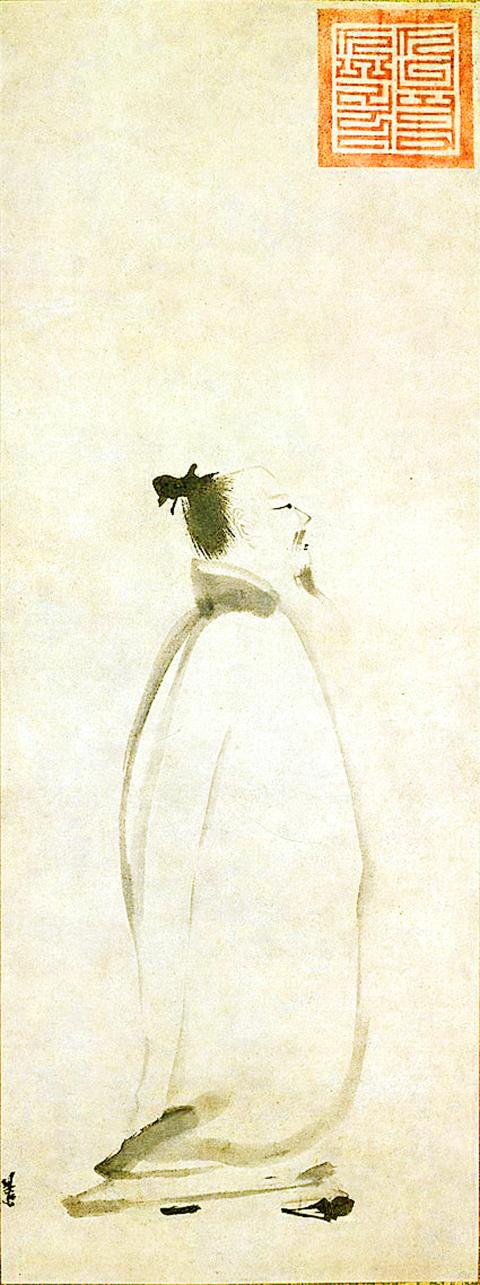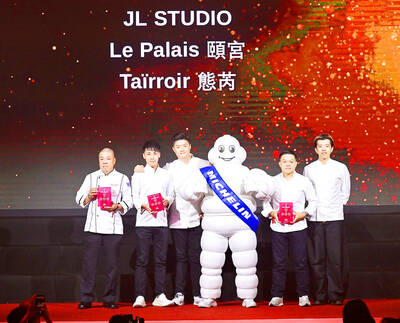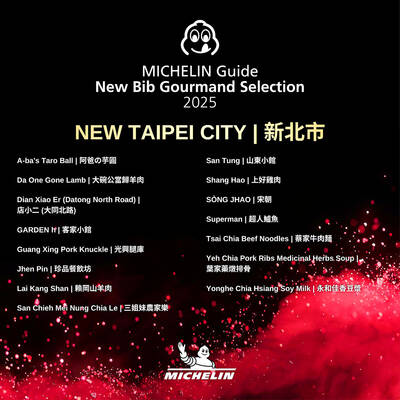Due to the peculiarities of the Chinese brush and ink, the painted line plays a crucial role in the depiction of form. On Sept. 30 Bilingual Arts looked at how the likeness of Vimalakirti was rendered in the style of Wu Daozi, who would build up clothing and form in his paintings with flowing lines.
The artist Liang Kai (approx. 1140 —1279) also painted his work Li Bai in Stroll with lines, although here he used broad strokes in an unrestrained style, using light tones. He painted the outline of the figure and clothing assertively, in what appears to be a single stroke, against a background he kept completely blank.
Liang captured the very essence of his subject with his precise control over brush and ink. With economical strokes, he created the collar with an ink wash, followed by the facial features — forehead, nose, eyebrow, eye, lips, jawline — in profile, using the tip of the brush, before painting on a wispy beard. The thickest ink he uses to paint on the top knot, then giving short flicks of the brush to depict individual strands of hair.

Photo: Wikimedia Commons
照片:維基共享資源
This is a representative work of the Chan (Zen) Buddhist painting style, employing bold yet free, succinct brushwork to create a rendition quite ahead of its time, capturing the unpretentious personality and laid back aspect of the poet Li Bai (701 — 762) as he strolls along, reciting verse.
Liang Kai was originally known for the meticulous brushwork of his landscapes and figurative paintings. He served in the imperial art academy, at the whim of the emperor, where it was said that everyone was in awe of the detailed quality of his paintings. He would later, however, eschew the status that came with the academy, and reject the detailed, meticulous painting style that it represented, turning instead to painting Buddhist and Taoist subjects, as well as the ancient sages. He began to imbue his work with the Buddhist and Taoist concept, popular at the time, of the moment of enlightenment, using simple brushstrokes to convey profundity. This style was called jianbi hua, meaning “minimalist painting.”
Liang Kai’s conversion from painting realistic depictions to focusing on how to capture the essential spirit of his subject could be said to be a reaction to the prevailing painting style of the time. As this jianbi hua style entailed the paring away of the unessential, what was left, with each stroke of the brush, was the most essential, the most able to capture the spirit of the subject: That, in itself, was incomparable precision, something that could only be achieved through the most ardent training in realist depiction.
(Translated by Paul Cooper, Taipei Times)
由於毛筆及水墨的工具特性,線條成為造形的極重要方式。九月三十日雙語藝術單元所介紹的吳道子風格的《維摩詰像》,便以流轉的細線條累積形塑人物的衣著與形象。
同樣是用線條造形,梁楷(約西元一一四○~一二七九年)的《李白行吟圖》卻是用粗闊狂放的筆勢與淡墨,幾乎是以單一的筆觸交代出著長袍的人物身形輪廓,背景則完全留白,作風大膽。
梁楷以筆墨準確地抓取事物的本質特徵:再添幾筆淡墨加厚高度成了領子,然後以筆尖輕盈幾筆交代出人物的側臉——額頭、鼻子、眉毛、眼睛、嘴唇、下巴,再刷出飄然的鬍鬚;最濃的墨畫出髮髻,再刷出頭髮,絲絲可見。
這是禪宗繪畫代表作之一,用筆簡練豪放、風格前衛,將詩仙李白(西元七○一~七六二年)不羈的個性及吟遊的瀟灑神態刻畫得極為生動。
梁楷早期以工筆細密的山水及人物畫享盛名,並曾被任命為畫院待詔,「院人見其精描之筆,無不拜伏」。然而,梁楷拒絕了畫院的高位、捨棄了精細繁複的畫法,轉以描繪佛道及古代高人逸士,並將當時盛行的禪宗佛教「頓悟」的精神帶入繪畫,以極簡的筆墨舉重若輕,被後人稱之為「簡筆畫」(或減筆畫)。
梁楷由「寫實」轉向「寫意」,可說是對當時畫風的反動。既然簡筆畫所減掉、抽去的是不重要的部分,那麼意味著所留下來的、所下的每一筆,都是最精到、最能抓住神韻——那其實是一種無比的精準,唯有深厚的寫實訓練才能夠提煉得出來。
(台北時報林俐凱)

In 2024, multiple airplane accidents caused severe casualties, including a Jeju Air disaster at the year’s end. However, not all incidents ended in tragedy. Early in the year, a Japan Airlines flight caught fire after landing in Tokyo, but all 379 passengers and crew members escaped within 90 seconds. This event highlights the “golden 90 seconds” that experts emphasize — most survivors evacuate the plane within this critical window. Proper preparation ensures you can act quickly and decisively during these crucial moments when every second counts. Your survival strategy begins before takeoff. Wear long pants, a comfortable top, and

If you think you’re cool and know all the latest trends, then here’s a question for you: What does the word “brat” mean? If you said something like, “a child who behaves badly or is annoying or rude,” you might not be as hip as you think. This four-letter word now has a new definition that has become quite popular. Its popularity caught the eye of Collins Dictionary, which crowned it as “Word of the Year 2024.” According to this new meaning of brat, it is used as an adjective to describe someone who has a confident, independent, and hedonistic

A: Seeing as the 2025 Michelin Guide extended to New Taipei City and Hsinchu City and County, it’s hard to believe that none of the restaurants won a Michelin star. B: Some fine establishments — like Hsinchu’s A Cut steakhouse — surely deserve the honor. A: Michelin-starred restaurants have good quality food, but some of them are so pricey. B: I once had barbeque pork at a starred restaurant that set me back NT$4,800. That’s even higher than my weekly food budget. A: No wonder several of them have closed down recently, as high prices and the tariff war are scaring off

A: The Michelin Guide Taiwan announced the 2025 Bib Gourmand eateries and starred restaurants last week. B: What were the highlights this year? A: In addition to Taipei, Taichung, Tainan and Kaohsiung, New Taipei City and Hsinchu City and County were included for the first time. B: As a New Taipei resident, I can’t wait to try all the awarded local delicacies. Should we start from the more affordable Bib Gourmand selection? A: Sure, New Taipei and Hsinchu each boast 15 Bib Gourmand eateries now, including some famous establishments such as San Tung restaurant. A: 2025《米其林指南》近日公布「必比登推介」和星級餐廳。 B: 今年的名單有哪些亮點? A: 除了台北、台中、台南、高雄,今年加入新北、新竹縣市! B: 身為新北人,我真想吃遍當地的美食,我們要不要從平價的必比登先開始? A: 好啊新北、新竹各有15家入選必比登,像山東小館等知名餐廳都有上榜唷。 (By Eddy Chang, Taipei Times/台北時報張迪)